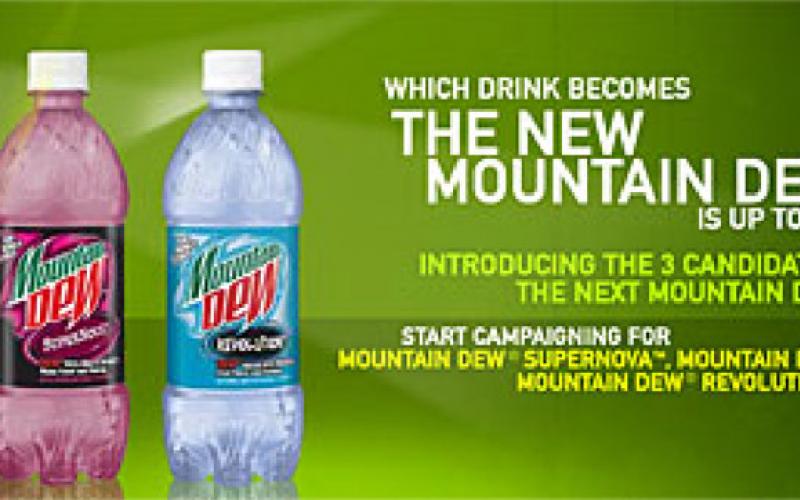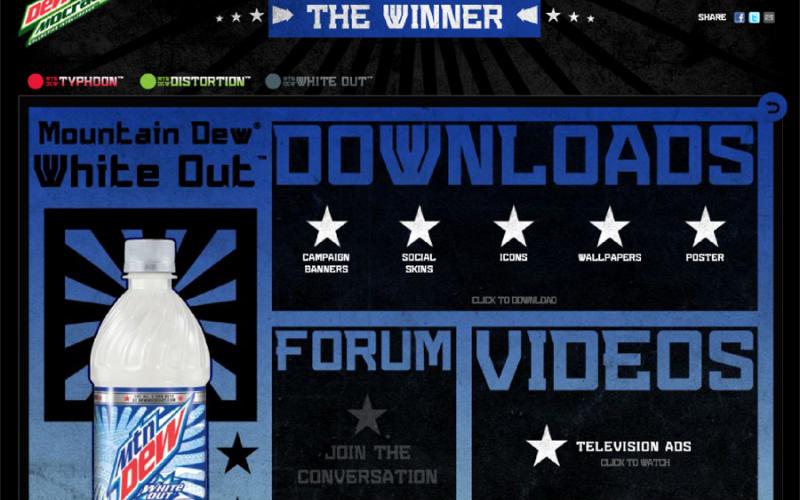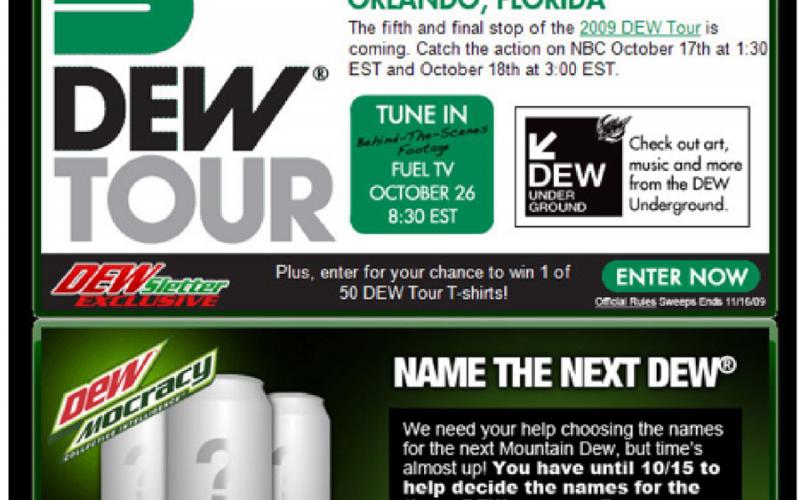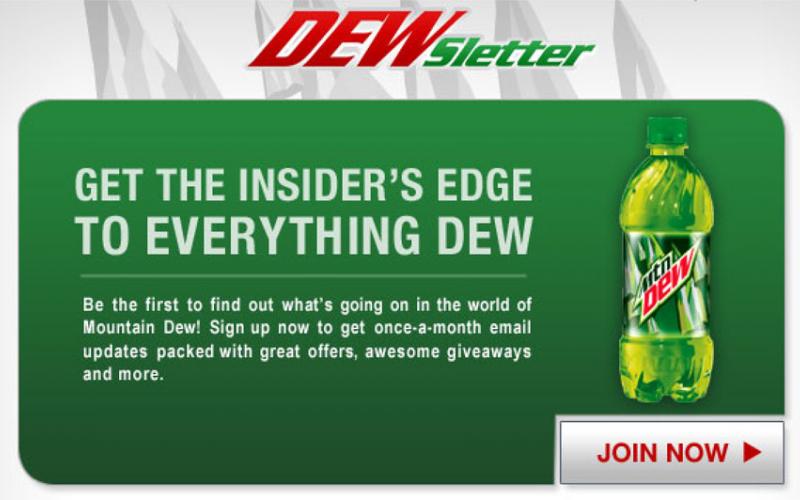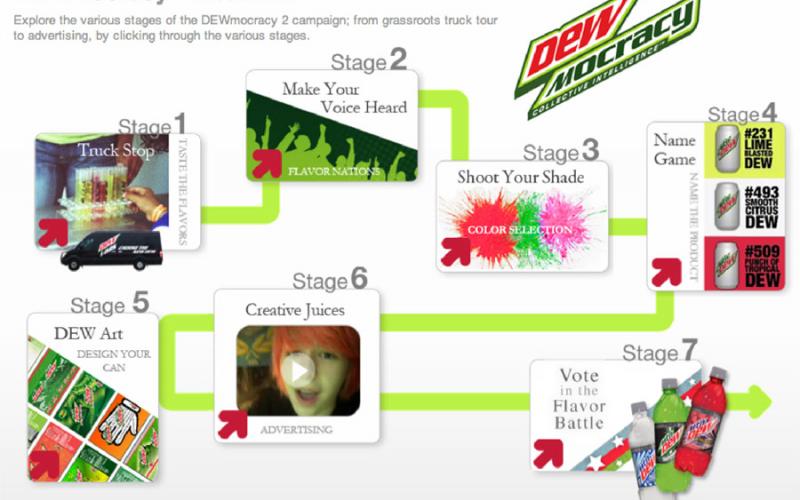Resources
Case Study: DEWmocracy
Mountain Dew’s DEWmocracy campaign embodies the fundamental strategy of engagement, which is now at the core of many digital marketing efforts1, including those that target youth. The first phase began in 2007 when Mountain Dew, frustrated by how much research and development time it was taking to create its next flavor, decided to turn the task over to consumers. A 3-D animation-based video game allowed players to develop the new drink’s color, flavor and label graphics. Participants were then asked to register at DEWmocracy.com where they promoted the product, asking followers to vote for their flavor. About 1.5 million users joined DEWmocracy, and Mountain Dew soon ranked “No. 1 on tweens’ list of ‘Newest Beverages’ they had tried and No. 2 among teens for that category.” In 2009, the company entered phase two of the campaign and took its engagement efforts a step further by launching DEW Labs, a private social network for “the brand’s most loyal fans.” Mountain Dew used this exclusivity to get fans to go the extra mile to promote new products.3
“[DEWlabs members are] … passionate not just in ‘I love this brand,’ but ‘I want to talk about it … it’s a part of my everyday;’ ‘I eat, drink, sleep Mountain Dew.’ It represents who they are.”
Techniques:
Creating immersive environments
The initial phase of the DEWmocracy campaign featured a 3-D animation-based video game, billed as the “first ever interactive story-based online game”, that allowed consumers to innovate new Mountain Dew products.5 The game was structured as a journey: Along the way, players participated in various “mythological experiences” and collected “tools to develop every aspect of a new Mountain Dew drink, including the color, flavor, and label graphics.”6
Infiltrating social networks
In the second phase of its campaign, Mountain Dew designed an ambitious seven-stage plan to generate a social movement to expand promotion of and engagement with the brand. DEWmocracy used social media to profile fan behaviors and identify the most influential social media users.7 The company then launched an exclusive, invitation-only social network, DEW Labs, to transform the most loyal fans into a street team dedicated to talking up the product.8 Fans used Facebook to vote for their preferred flavors and followed their favorite contender as part of a Twitter race. The campaign also included a presence on video sites YouTube, USTREAM and 12seconds.tv.9
Location-based and mobile marketing
Mountain Dew has been an early proponent of mobile marketing, using games and mobile apps to help drive beverage sales. For example, in 2008, Mountain Dew’s parent company, PepsiCo, launched a mobile widget that used the 1950s icon Willy the Hillbilly to better engage consumers.10 And more recently, Mountain Dew teamed up with the picture-sharing game Pongr and offered “DEW Bucks” to those who emailed or texted in pictures of themselves drinking Mountain Dew. Top game players could then redeem DEW Bucks for prizes.11
Collecting personal data
Using PepsiWorld, a data collection service, Mountain Dew is able to gather wide range of information on specific consumers. Information includes consumers’ street address, email address, phone number and gender, as well as what soft drinks they prefer, and how often they consume Pepsi Products.12,13 Such tailored information allows Mountain Dew to stay in constant contact with consumers and offer free promotional items to keep young people engaged with the brand.
References:
1. Zmuda, N. (2009, November 2). New Pepsi ‘Dewmacracy’ Push Threatens to Crowd Out Shops. Advertising Age. Retrieved August 7, 2010 from http://adage.com/agencynews/article?article_id=140120.
2. Lentini, N. (2009, April 1). Cross-Media Case Study: Plugged in to the Electorate. OMMA Magazine. Retrieved August 7, 2010 from http://www.mediapost.com/publications/?fa=Articles.showArticle&art_aid=102488.
3. Cirillo, J. (2010, March 11). DEWmocracy 2 Continues to Buzz. Beverage World. Retrieved October 12, 2011 from http://www.beverageworld.com/index.php?option=com_content&view=article&id=37525:dewmocracy-2-continues-to-buzz&catid=34.
4. DEW Labs. (2010, April 17). How To: Get Into DEWlabs. Retrieved August 7, 2010 from http://dewlabs.blogspot.com/2010/04/how-to-get-into-dewlabs.html.
5. BevReview.com. (2008, February 27). Commentary: DEWmocracy and Mountain Dew’s Online Marketing. Retrieved October 12, 2011 from http://www.bevreview.com/2008/02/27/commentary-dewmocracy-and-mountain-dews-online-marketing/.
6. BevReview.com. (2008, February 27). Commentary: DEWmocracy and Mountain Dew’s Online Marketing. Retrieved October 12, 2011 from http://www.bevreview.com/2008/02/27/commentary-dewmocracy-and-mountain-dews-online-marketing/.
7. Montgomery, K., Chester J. (2011, October). Digital Food Marketing to Children and Youth: Problematic Practices and Policy Interventions. National Policy and Legal Analysis Network to Prevent Childhood Obesity. http://case-studies.digitalads.org/wp-content/uploads/2011/10/DigitalMarketingReport_FINAL_web_20111017.pdf.
8. Cirillo, J. (2010, March 11). DEWmocracy 2 Continues to Buzz. Beverage World. Retrieved October 12, 2011 from http://www.beverageworld.com/index.php?option=com_content&view=article&id=37525:dewmocracy-2-continues-to-buzz&catid=34.
9. Cirillo, J. (2010, March 11). DEWmocracy 2 Continues to Buzz. Beverage World. Retrieved October 12, 2011 from http://www.beverageworld.com/index.php?option=com_content&view=article&id=37525:dewmocracy-2-continues-to-buzz&catid=34.
10. Khan, M.A. (2008, May 15). PepsiCo launches branded mobile widget for Mountain Dew. Mobile Marketer. Retrieved October 11, 2011 from http://www.mobilemarketer.com/cms/news/gaming/996.html.
11. PONGR Blog. Mountain Dew Pongr game overview. Retrieved October 11, 2011 from http://blog.pongr.com/2011/02/06/mountain-dew-pongr-game-overview/.
12. MountainDew.com. Join Dew. Retrieved August 8, 201 from http://mountaindew.com/?or=pxtras#/join/joindew.php.
13. Pepsi-Cola Company. Privacy Policy. Retrieved August 9, 2010 from http://www.pepsiusa.com/privacypolicy.php.


